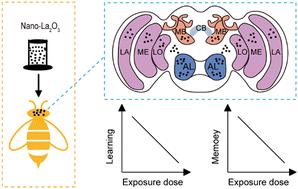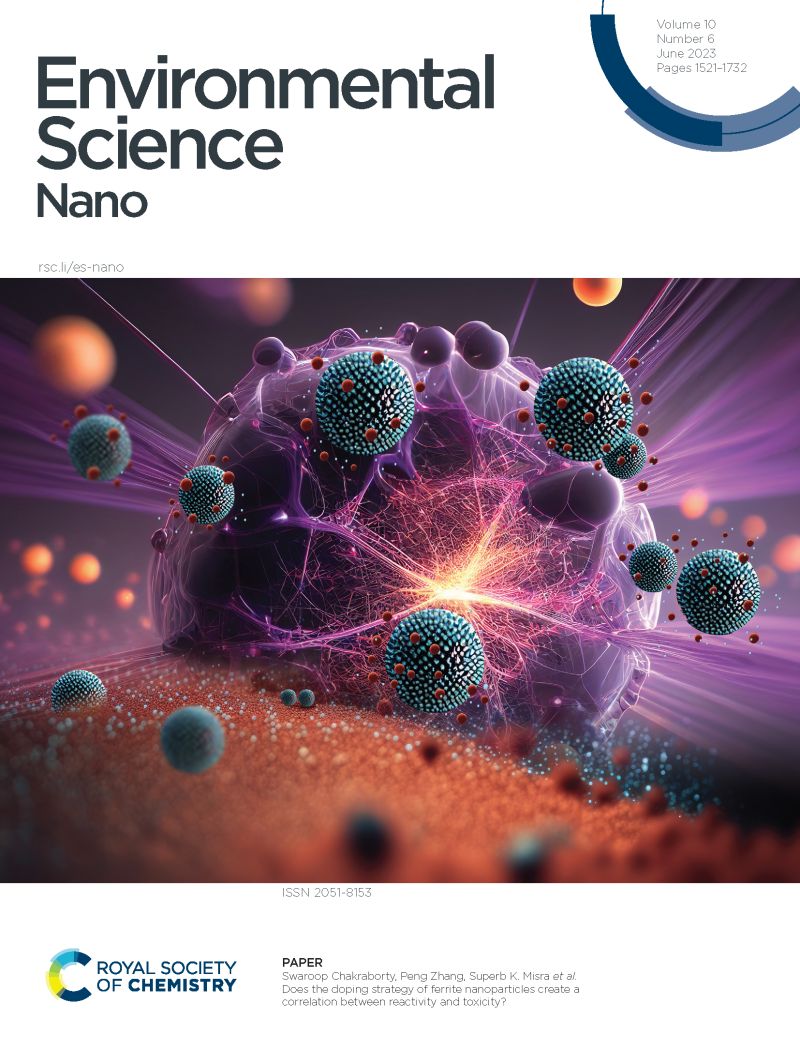Nano-La2O3 undermines honeybee cognition by invading the brain and accelerating neuronal apoptosis
IF 5.1
2区 环境科学与生态学
Q1 CHEMISTRY, MULTIDISCIPLINARY
引用次数: 0
Abstract
The widespread application of nanoparticles in agriculture poses threats to pollinators like honeybees, but the mechanisms of nanoparticle effects on honeybee cognitive behaviours remain poorly understood. To begin to address this knowledge gap, we examined the cognitive and physiological implications of lanthanum oxide nanoparticles (nano-La2O3) on honeybees (Apis mellifera L.). Our findings revealed that exposure to nano-La2O3 (e.g., >10 mg L−1) significantly impaired olfactory associative learning and memory of honeybees (p < 0.05) in a dose-dependent fashion, attributable to the increased apoptosis of neural cells and the downregulation of genes related to cognitive functions (cAMP-dependent protein kinase (pka), cAMP-responsive element binding protein (creb), n-methyl-D-aspartate receptor 1 (nmdar1)) due to the invasion of nano-La2O3 into brains. This further led to decreased sucrose consumption and reduced survival rates among exposed honeybees. Our research documents the first evidence of nano-La2O3 accumulation in honeybee brains and provides insights into the mechanisms through which nanoparticles negatively affect the cognitive behaviour of honeybees, highlighting new potential ecological risks posed by nanomaterials.

纳米la2o3通过入侵大脑和加速神经元凋亡来破坏蜜蜂的认知能力
纳米颗粒在农业中的广泛应用对蜜蜂等传粉媒介构成了威胁,但纳米颗粒对蜜蜂认知行为的影响机制仍然知之甚少。为了解决这一知识差距,我们研究了氧化镧纳米粒子(纳米la2o3)对蜜蜂(Apis mellifera L.)的认知和生理影响。我们的研究结果表明,暴露于纳米la2o3(例如,10 mg L - 1)显著损害蜜蜂的嗅觉联想学习和记忆(p < 0.05),并呈剂量依赖性,这是由于纳米la2o3入侵大脑导致神经细胞凋亡增加和认知功能相关基因(camp依赖性蛋白激酶(pka)、camp响应元件结合蛋白(creb)、n-甲基-d -天冬氨酸受体1 (nmdar1))的下调。这进一步减少了蔗糖的消耗,降低了蜜蜂的存活率。我们的研究记录了纳米la2o3在蜜蜂大脑中积累的第一个证据,并提供了纳米颗粒对蜜蜂认知行为产生负面影响的机制的见解,强调了纳米材料带来的新的潜在生态风险。
本文章由计算机程序翻译,如有差异,请以英文原文为准。
求助全文
约1分钟内获得全文
求助全文
来源期刊

Environmental Science: Nano
CHEMISTRY, MULTIDISCIPLINARY-ENVIRONMENTAL SCIENCES
CiteScore
12.20
自引率
5.50%
发文量
290
审稿时长
2.1 months
期刊介绍:
Environmental Science: Nano serves as a comprehensive and high-impact peer-reviewed source of information on the design and demonstration of engineered nanomaterials for environment-based applications. It also covers the interactions between engineered, natural, and incidental nanomaterials with biological and environmental systems. This scope includes, but is not limited to, the following topic areas:
Novel nanomaterial-based applications for water, air, soil, food, and energy sustainability
Nanomaterial interactions with biological systems and nanotoxicology
Environmental fate, reactivity, and transformations of nanoscale materials
Nanoscale processes in the environment
Sustainable nanotechnology including rational nanomaterial design, life cycle assessment, risk/benefit analysis
 求助内容:
求助内容: 应助结果提醒方式:
应助结果提醒方式:


